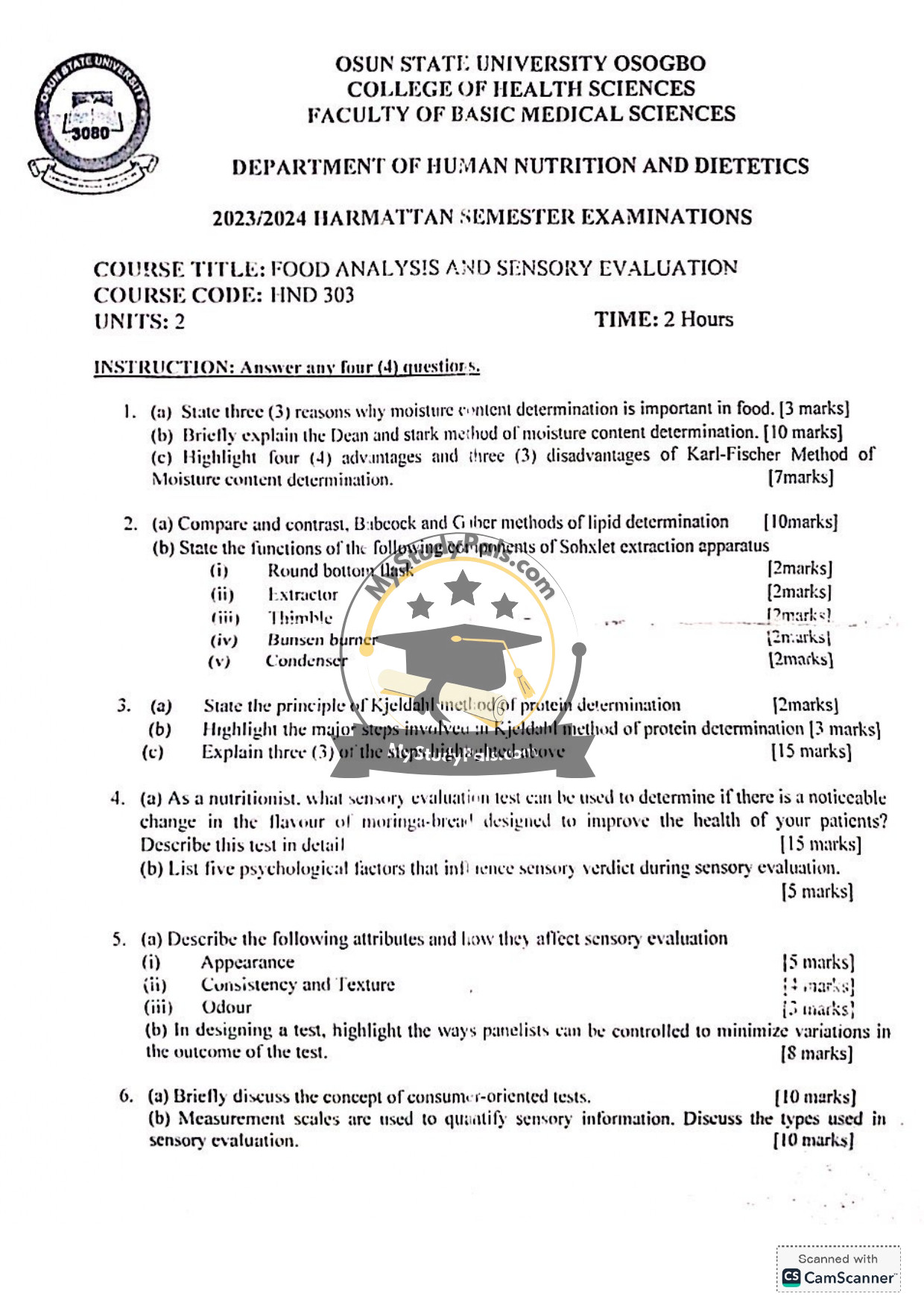ANWSER
Question 1:
(a) Three reasons why moisture content determination is important in food:
1. Shelf-life stability: Moisture affects microbial growth and enzymatic activity, influencing spoilage rates.
2. Nutritional labeling: Accurate moisture content ensures correct calculation of nutritional components.
3. Quality control: Moisture impacts texture, taste, and consistency of food products.
(b) Dean and Stark method:
This method involves distilling a food sample mixed with a water-immiscible solvent (e.g., toluene) in a specialized apparatus. The mixture is heated, and water vaporizes, condenses, and collects in a graduated tube. The solvent continuously refluxes, separating water from the sample. The volume of collected water is measured to calculate moisture content. It is particularly suited for high-moisture or fatty foods.
(c) Karl-Fischer Method:
Advantages:
1. High accuracy and precision, even for trace moisture levels.
2. Rapid results compared to oven-drying methods.
3. Suitable for a wide range of food matrices.
Disadvantages:
1. Expensive equipment and reagents.
2. Susceptible to interference from substances like ketones or aldehydes.
3. Requires skilled personnel for operation and maintenance.
—
Question 2:
(a) Comparison of Babcock and Gerber methods:
– Similarities: Both are gravimetric methods for lipid determination, use acid digestion, and are common in dairy analysis.
– Differences:
– Babcock: Uses sulfuric acid and centrifugation; designed for milk. Fat separates into a graduated column for measurement.
– Gerber: Employs sulfuric acid, amyl alcohol, and a butyrometer; used for cheese and viscous dairy products.
(b) Functions of Soxhlet apparatus components:
1. Round bottom flask: Holds the solvent and collects extracted lipids after distillation.
2. Extractor: Automatically siphons the solvent back into the flask after each cycle.
3. Thimble: Holds the solid sample, allowing solvent to percolate through it.
4. Bunsen burner: Provides heat to vaporize the solvent.
5. Condenser: Cools solvent vapors, converting them back to liquid for recycling.
—
Question 3:
(a) Principle of Kjeldahl method:
The method quantifies protein by converting organic nitrogen into ammonium sulfate via acid digestion, followed by distillation and titration to measure nitrogen content, which is then multiplied by a factor (typically 6.25) to estimate protein.
(b) Major steps:
1. Digestion: Sample is boiled in concentrated sulfuric acid with a catalyst to release nitrogen as ammonium ions.
2. Distillation: Ammonium ions are alkalized to liberate ammonia, which is distilled into a trapping solution.
3. Titration: The trapped ammonia is titrated to determine nitrogen content.
(c) Explanation of steps:
1. Digestion: Sulfuric acid breaks down proteins into amino acids, then further oxidizes them to NH₃, which binds with H₂SO₄ to form (NH₄)₂SO₄.
2. Distillation: NaOH is added to neutralize the acid, releasing NH₃ gas, which is condensed into a boric acid solution.
3. Titration: The ammonia-boric acid complex is titrated with HCl to calculate nitrogen content.
—
Question 4:
(a) Sensory evaluation test:
A Triangle Test is suitable. Panelists receive three samples (two identical, one modified) and must identify the odd one. Steps:
1. Blinding: Samples are coded and randomized.
2. Environment: Controlled setting to minimize external influences.
3. Analysis: Statistical tests (e.g., chi-square) determine if correct identifications exceed chance (p < 0.05).
(b) Psychological factors:
1. Expectation bias (preconceived notions).
2. Mood or emotional state.
3. Cultural or dietary preferences.
4. Sensory fatigue.
5. Peer influence or groupthink.
—


